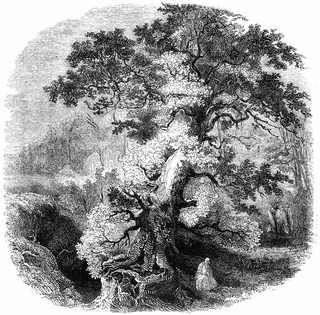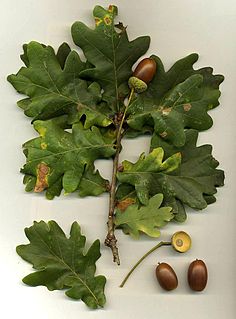
Gwydion fab Dôn is a magician, hero and trickster of Welsh mythology, appearing most prominently in the Fourth Branch of the Mabinogi, which focuses largely on his relationship with his young nephew, Lleu Llaw Gyffes. He also appears prominently in the Welsh Triads, the Book of Taliesin and the Stanzas of the Graves.
In Welsh mythology, Math fab Mathonwy, also called Math ap Mathonwy was a king of Gwynedd who needed to rest his feet in the lap of a virgin unless he was at war, or he would die. The story of Math is the fourth of the Four Branches of the Mabinogi.
Arianrhod is a figure in Welsh mythology who plays her most important role in the Fourth Branch of the Mabinogi. She is the daughter of Dôn and the sister of Gwydion and Gilfaethwy; the Welsh Triads give her father as Beli Mawr. In the Mabinogi her uncle Math ap Mathonwy is the King of Gwynedd, and during the course of the story she gives birth to two sons, Dylan ail Don and Lleu Llaw Gyffes, through magical means.

Blodeuwedd or Blodeuedd, , is the wife of Lleu Llaw Gyffes in Welsh mythology. She was made from the flowers of broom, meadowsweet, and oak by the magicians Math and Gwydion, and is a central figure in Math fab Mathonwy, the last of the Four Branches of the Mabinogi.
Dylan ail Don is a character in the Welsh mythic Mabinogion tales, particularly in the fourth tale, "Math fab Mathonwy". The story of Dylan reflects ancient Celtic myths that were handed down orally for some generations before being written down during the early Christian period by clerics. The story as it has been preserved therefore exhibits elements and archetypes characteristic of both Celtic pagan and Christian mythologies. His name translates as "Dylan the Second Wave", referring to him as being the second born of Arianrhod.
In Irish, a geas is an idiosyncratic taboo, whether of obligation or prohibition, similar to being under a vow. The plural geasa is also used to mean specifically a spell prohibiting some action, common in Irish folklore and mythology. It is this additional meaning of the plural which the article discusses.
Cad Goddeu is a medieval Welsh poem preserved in the 14th-century manuscript known as the Book of Taliesin. The poem refers to a traditional story in which the legendary enchanter Gwydion animates the trees of the forest to fight as his army. The poem is especially notable for its striking and enigmatic symbolism and the wide variety of interpretations this has occasioned.

The Owl Service is a low fantasy novel for young adults by Alan Garner, published by Collins in 1967. Set in modern Wales, it is an adaptation of the story of the mythical Welsh woman Blodeuwedd, an "expression of the myth" in the author's words.
Lot, Loth or Lothus is the king of Lothian, the realm of the Picts in the Arthurian legend. Such a ruler first appeared late in the 1st millennium's hagiographical material concerning Saint Kentigern, which feature a Leudonus, king of Leudonia, a Latin name for Lothian. In the 12th century, Geoffrey of Monmouth adapted this to Lot, king of Lothian, in his influential chronicle Historia Regum Britanniae, portraying him as King Arthur's brother-in-law and ally. In the wake of Geoffrey's writings, Lot appeared regularly in later romance.
Ardudwy is an area of Gwynedd in north-west Wales, lying between Tremadog Bay and the Rhinogydd. Administratively, under the old Kingdom of Gwynedd, it was first a division of the sub kingdom (cantref) of Dunoding and later a commote in its own right. The fertile swathe of land stretching from Barmouth to Harlech was historically used as pasture.

Welsh mythology consists of both folk traditions developed in Wales, and traditions developed by the Celtic Britons elsewhere before the end of the first millennium. Like most predominately oral societies found in the prehistoric Britain, Welsh mythology and history was recorded orally by specialists such as druids. This oral record has been lost or altered as result of outside contact and invasion over the years. Much of this altered mythology and history are preserved in medieval Welsh manuscripts which include the Red Book of Hergest, the White Book of Rhydderch, the Book of Aneirin and the Book of Taliesin. Other works connected to Welsh mythology include the ninth century Latin historical compilation Historia Brittonum and Geoffrey of Monmouth's twelfth-century Latin chronicle, Historia Regum Britanniae as well as later folklore such as the 1908 The Welsh Fairy Book by William Jenkyn Thomas.
The Four Branches of the Mabinogi or Pedair Cainc Y Mabinogi are the earliest prose stories in the literature of Britain. Originally written in Wales in Middle Welsh, but widely available in translations, the Mabinogi is generally agreed to be a single work in four parts, or "Branches." The interrelated tales can be read as mythology, political themes, romances, or magical fantasies. They appeal to a wide range of readers, from young children to the most sophisticated adult. The tales are popular today in book format, as storytelling or theatre performances; they appear in recordings and on film, and continue to inspire many reinterpretations in artwork and modern fiction.

The mediaeval Welsh cantref of Arfon in north-west Wales was the core of the Kingdom of Gwynedd. Later it was included in the new county of Caernarfonshire, together with Llŷn and Arllechwedd under the terms of the Statute of Rhuddlan in 1284. The island of Anglesey faced it across the Menai Strait; to the east was the cantref of Arllechwedd, to the south the cantref of Eifionydd, and to the west was the cantref of Llŷn.

The Island of the Mighty is a fantasy novel by American writer Evangeline Walton, the earliest in a series of four based on the Welsh Mabinogion. It was first published in 1936 under the publisher's title of The Virgin and the Swine. Although it received warm praise from John Cowper Powys, the book sold poorly, and as a result none of the other novels in the series reached print at the time. Later rediscovered by Ballantine Books, it was reissued under the present title as the eighteenth volume of the Ballantine Adult Fantasy series in July, 1970, with an introduction by Lin Carter and a cover by Bob Pepper. It has been reprinted a number of times since, and gathered together with Walton's other Mabinogion novels by Overlook Press as the omnibus The Mabinogion Tetralogy in 2002. The novel has also been published in translation in several European languages.
The Holly King is a speculative archetype of modern studies of folklore and mythology which has been popularized in some Neopagan religions. In his book The White Goddess, the author Robert Graves proposed that the mythological figure of the Holly King represents one half of the year, while the other is personified by his counterpart and adversary the Oak King: the two battle endlessly as the seasons turn. At Midsummer the Oak King is at the height of his strength, while the Holly King is at his weakest. The Holly King begins to regain his power, and at the Autumn Equinox, the tables finally turn in the Holly King's favor; his strength peaks at Midwinter. Graves identified a number of paired hero-figures which he believes are variants of this myth, including Lleu Llaw Gyffes and Gronw Pebr, Gwyn and Gwythr, Lugh and Balor, Balan and Balin, Gawain and the Green Knight, the robin and the wren, and even Jesus and John the Baptist.

Many types of trees found in the Celtic nations are considered to be sacred, whether as symbols, or due to medicinal properties, or because they are seen as the abode of particular nature spirits. Historically and in folklore, the respect given to trees varies in different parts of the Celtic world. On the Isle of Man, the phrase 'fairy tree' often refers to the elder tree. The medieval Welsh poem Cad Goddeu is believed to contain Celtic tree lore, possibly relating to the crann ogham, the branch of the ogham alphabet where tree names are used as mnemonic devices.
This is a list of elements of Welsh mythology that have appeared in popular culture.
Llech Ronw, or the Slate of Gronw, is a holed stone located along Afon Bryn Saeth in Blaenau Ffestiniog, Wales. The stone is described as being roughly forty inches by thirty inches with a hole of about an inch in diameter going through it.
Math fab Mathonwy, "Math, the son of Mathonwy" is a legendary tale from medieval Welsh literature and the final of the four branches of the Mabinogi. It tells of a vicious war between the north and the south, of the birth of Lleu Llaw Gyffes and Dylan ail Don, of the tyngedau of Arianrhod, and of the creation of Blodeuwedd, a woman made of flowers. The chief characters of the tale are Math, king of Gwynedd, his nephew Gwydion, a magician, warrior and trickster, and Gwydion's own nephew, Lleu, cursed by his mother Arianrhod.














